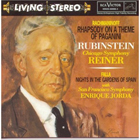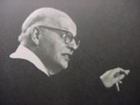
Transition Years at the SF Symphony
This is the fourth in a series of articles covering the San Francisco Symphony's discographic history. You may find the first installment, covering the Pierre Monteux years, here. I luxuriated in the lavish Blomstedt catalog first in this post, and then in this one, at the end of which I promised Edo de Waart's tenure as the subject of Part 4.
An artist reserves the right to change his mind, and as I'm definitely an artist, I have changed my mind. I'm not going to talk about De Waart today, but the topic will come, it will come.
You see, it occurs to me that De Waart's tenure at the SFS makes better sense when viewed in its proper historical context. So: one proper historical context, coming up.
I cite late, longtime symphony violinist David Schneider's The San Francisco Symphony: Music, Maestros, and Musicians frequently in this article. David's book is a valuable insider's take on the SFS's history from the 1940s through De Waart's time. It's one person's viewpoint, of course — other musicians might have taken a different tack, as might have administrators or critics. But David spoke from a musician's close personal experience, nor did he pull any punches; he offered praise and blame as he felt warranted. He was an honorable man who avoided the twin pitfalls of hagiography and character assassination, and his book offers a rare glimpse into the working life of an orchestra musician.
Pierre Monteux retired from the SFS at the end of the 1952 season, having officiated since the orchestra's 1935 rebirth following its near-death experience at the hands of the Depression. Under his stewardship, the Symphony had blossomed, flourished, and acquired national exposure via piles of RCA Victor records.
Schneider sums up Monteux's legacy as follows:
He was a solid conductor who left behind him an orchestra well schooled in many styles of music...The unhappiness was that opportunities were lost. Too often Monteux would settle for 'good enough.' Occasionally there was a Franck, a Berlioz, a Ravel, or a Brahms piece that gave us a glimpse of those heights we were capable of scaling. But Monteux did not have the drive necessary to insist on that type of performance at all times...The San Francisco Symphony was an orchestra well prepared to do the very best, but it was not yet one of the country's great orchestras.
Over the following two years, a series of guest conductors were offered a trial shot at filling those hallowed Gallic shoes. One may imagine an alternate future in which, say, the young Erich Leinsdorf had been offered the post, or veteran William Steinberg; intriguing. Of the many luminaries who visited San Francisco in those years, it was dark horse Enrique Jordá — flamboyant in concert but skimpy in resumé — who won the podium in 1954.
Jordá's tenure began auspiciously, but in time his limitations were to become glaringly obvious. Jordá was often electrifying onstage, but his disorganized rehearsal technique proved a disaster for an orchestra that had already acquired a somewhat cavalier attitude towards preparation. David Schneider: "That we got through each concert, sometimes very well, sometimes in a shaky fashion but never completely disastrously, can be attributed not only to Jordá, who put out such great effort during the concert, but to the professionalism of the orchestra members."
To paraphrase David's generous, cup-half-full verdict: Well, it could have been a lot worse. Faint praise indeed. Once again San Francisco was marching to a different drummer, but this time those other folks were heading uphill while the City was trudging down.
The 1950s were a true golden age of American orchestral playing; consider Fritz Reiner's Chicago Symphony, the Cleveland Orchestra under George Szell, and Charles Munch in Boston. Their recordings stand today as classics — in some cases setting such high benchmarks as to be the despair of succeeding generations.
But the San Francisco Symphony played no part in that abundant efflorescence; instead, it wilted. The former flood of records dwindled to a trickle, then stopped altogether. Jordá's discography with the SFS is minuscule, consisting of six works in all, four of which have been out of print since the 1960s. The two remaining selections — both concertos — owe their survival to the star power of their soloists.
 Artur Rubinstein recorded Manuel de Falla's Nights in the Gardens of Spain with the SFS in 1957, as the flip side of his iconic performance of the Rachmaninoff Paganini Variations with Reiner/Chicago. It's an excellent recording on all counts; if Jordá's SFS had sounded like this as a rule, certainly there would have been no problem.
Artur Rubinstein recorded Manuel de Falla's Nights in the Gardens of Spain with the SFS in 1957, as the flip side of his iconic performance of the Rachmaninoff Paganini Variations with Reiner/Chicago. It's an excellent recording on all counts; if Jordá's SFS had sounded like this as a rule, certainly there would have been no problem.
Alexander Brailowsky's experience with the orchestra was conspicuously less fortunate. Recording the Rachmaninoff Second Piano Concerto turned out to be an ordeal for all concerned. David Schneider does not mince words: "Jordá's ineptness in accompanying was magnified on the recordings, and we had to do it over several times. All the repetitions began to show on Brailowsky. He began to tire, and mistakes cropped up in his usually infallible performance. After five hours, we finally finished the recording, a mediocre one at best." Blunt but honest.
Although the administration continued to back Jordá, public support was dwindling. It took über-conductor George Szell, tyrannical overlord of the mighty Cleveland Orchestra, to lower the boom.
Engaged as guest conductor for two weeks in spring 1962, Szell walked out after the first week, plainly dissatisfied with the orchestra's condition, despite the musicians's sincere efforts to raise their performance levels to his exacting standards. Of course a polite cover story was offered and the whole thing might have blown over. Alas, a local critic took it upon himself to write Szell a chiding letter which elicited a blistering reply — published in the Examiner — condemning the orchestra's condition as: "...the saddest state of musical affairs I have encountered in any American or European city during the almost fifty years of my active conducting career."
So much for the polite cover story, and so much for Enrique Jordá.
Enter Josef Krips, a late specimen of the nearly extinct species of hyper-vigilant Austrian martinets. It was Krips's charge to reform, renew, and revamp the orchestra — a task that he carried out with terrifying efficiency.
 The Krips years appear to have been a turbulent time for some of the orchestra members, characterized by job insecurity and internal friction. Krips could behave with almost unbelievable rudeness to the players (Peasants!, he once snarled at them) but he was also capable of magnanimous gestures of support. Performance standards went up, up, up, as did orchestral antacid consumption.
The Krips years appear to have been a turbulent time for some of the orchestra members, characterized by job insecurity and internal friction. Krips could behave with almost unbelievable rudeness to the players (Peasants!, he once snarled at them) but he was also capable of magnanimous gestures of support. Performance standards went up, up, up, as did orchestral antacid consumption.
Krips refused to allow the orchestra to record, but towards the end of his tenure (around 1969) he did green-light the occasional Friday night live broadcast on KKHI. Bootlegs are floating around, and judging from the ones I've heard, the SFS was definitely back in tiptop form. It was high time for the San Francisco Symphony's return to the recording studio, but that wasn't going to happen without a change in leadership.
Since David Schneider has (posthumously) co-authored today's column, let him offer the closing benediction:
Though Krips had a long history of recording, he had done none with us. He thought the orchestra had never quite reached the degree of proficiency necessary for making recordings — 'just one more change of personnel,' and it could have been done. But since that never happened, he was never ready to record. Many works he conducted with us would have made memorable recordings, but all this has been lost.
Coming up: Ozawa and De Waart, then odds 'n' ends conductors, then MTT. That is, unless I change my mind again...
A few links:
- Enrique Jordá's complete discography (including other orchestras) on ArkivMusic
- Josef Krip's complete discography (no SFS) on ArkivMusic
- Time Magazine's 1963 article on Josef Krips's appointment
- David Schneider's The San Francisco Symphony: Music, Maestros, and Musicians on Amazon
- Paperback
- Hardcover
- The San Francisco Symphony's onsite history
- Enrique Jordá's obituary in the New York Times
